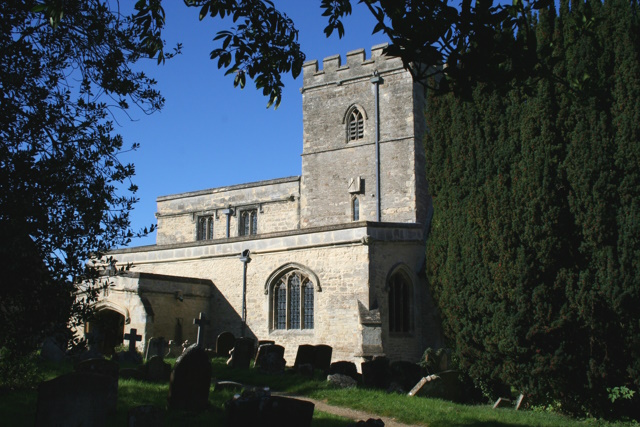


























The Church of the Assumption of the Blessed Virgin Mary, Beckley
The church of The Assumption of the Blessed Virgin Mary in Beckley consists of a nave, chancel, north and south aisles, south porch, and central embattled tower. It dates from the 14th and 15th centuries, and is unusual in retaining almost all its original stonework, including the tracery in the windows. There was an earlier church on the site, of which only part of the north wall of the chancel and the font (c. 1200) remain. During the early 14th century the chancel and south aisle were rebuilt, and the central tower was probably added at the same time. The north aisle was rebuilt towards the end of the century, and in the 15th century the present nave arches were inserted, with a clerestory above, and the west wall rebuilt. The south porch was added later in the century, and new windows and a doorway were inserted in the south aisle. Minor repairs to the fabric, especially the porch, were made about 1758, and in 1788 a gallery was erected by subscription from Horton and Whitecross Green, 'for the use of the singers'. In 1844 the churchyard was newly fenced, and a thorough restoration of the church was made in 1845. A plaster ceiling was removed to reveal the original timber roof, the squint on the south side was opened, the gallery taken down, the pews replaced by open seats, the Jacobean pulpit cleaned of its paint and 'let down to reasonable proportions', and a stone altar substituted for the old wooden altar. The church has some 14th-century glass in the windows of the north aisle and chancel, depicting the Assumption of the Virgin, St. Anne teaching the Virgin to read, the martyr king St. Edmund, holding an arrow, the legend of St. Thomas and the Virgin's girdle, St. Christopher, and St. Thomas. There are considerable remains of wall-paintings which were discovered in 1845: a 14th-century Madonna on the north wall of the south aisle; and scenes depicting the Annunciation, possibly, and the roasting of the damned in hell. On top of these scenes was painted a large 15th-century Weighing of Souls, now largely destroyed. Above the western tower-arch are figures of St. Peter and St. Paul, dating from the 14th century, and a Doom, with an 18th-century Royal Arms painted above its centre. On the west wall are considerable remains of colour decoration, mostly of the early 17th century. Above the font, on the north-east pillar of the nave, is an unusual small stone desk supported by a shaft, made to hold the manual. The fine 13thcentury ironwork on the inner door of the porch is another notable survival. The monuments commemorate some well-known local families, notably those of Croke, Bee, Cooke, Ledwell, and Faulkner. Owing to alterations in the floor levels, most of the 17th-century and early18th-century inscriptions described in 1717 and again in 1823 have since disappeared. Among the many Izard memorials was one to John Izard, Spanish merchant (d. 1694). There are now inscriptions to Robert Sutton, barber in the University of Oxford (d. 1742); John Thomson, B.D. (d. 1773/4) and Laetitia Thomson (d. 1746); Ann, daughter of John and Mary Faulkner of Studley (d. 1759); William Ledwell, of Woodperry (d. 1779); Mary, wife of Thomas Ledwell of Beckley Park (d. 1783), and to five children, presumably, who died between 1782 and 1804; Edward Bee and Mary, his wife; Ann, wife of the Revd. Dr. Leigh; Cassandra Cooke (d. 1826), wife of the Revd. Samuel Cooke and daughter of Ann and the Revd. Dr. Leigh, Master of Balliol; John Parker (d. 1805); Jenny Parker, relict of John and daughter of Alexander Croke (d. 1814); Alexander Croke, eldest son of Sir Alexander Croke (d. 1818); Le Blount Croke (d. 1827); Alexander Croke (d. 1833). The earliest Croke monument now left is a brass depicting Anne, wife of Charles Croke, kneeling at a prie-dieu. She died in 1619. Full inventories were taken in 1552 and 1553, when the church had four large bells, a sanctus bell and a chalice without a cover. The chapel light, which had 12d. a year for its maintenance and was removed by Edward VI's commissioners, probably stood in the south aisle. There are now five bells, two from the 17th, two from the 18th, and one from the 19th century, and also a sanctus bell. The earliest piece of church plate now left is a silver paten-cover of 1764. Historical information about The church of The Assumption of the Blessed Virgin Mary is provided by 'Parishes: Beckley', in A History of the County of Oxford: Volume 5, Bullingdon Hundred, ed. Mary D Lobel (London, 1957), pp. 56-76. British History Online http://www.british-history.ac.uk/vch/oxon/vol5/pp56-76 [accessed 17 March 2023]. The church of The Assumption of the Blessed Virgin Mary is a Grade I listed building. For more information about the listing see CHURCH OF THE ASSUMPTION OF THE BLESSED VIRGIN MARY, Beckley and Stowood - 1047650 | Historic England. For more information about The church of The Assumption of the Blessed Virgin Mary see Parishes: Beckley | British History Online (british-history.ac.uk). |

